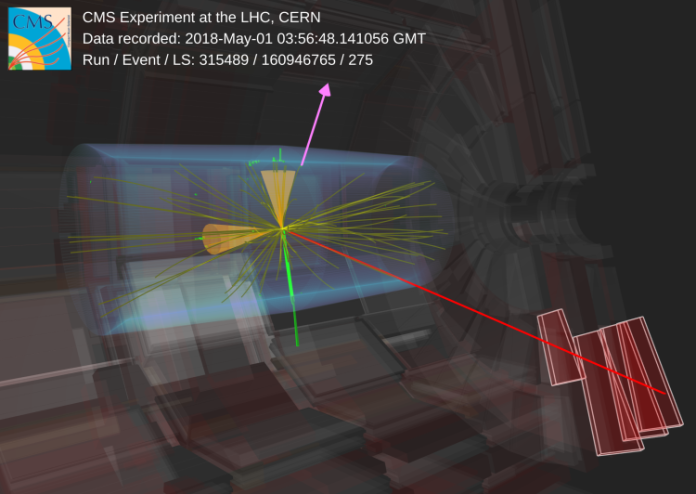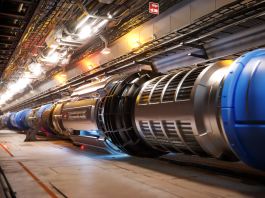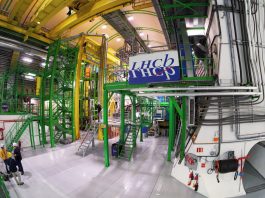Scientists at CERN’s Large Hadron Collider (LHC) have uncovered an unexpected anomaly in their data, which could suggest the existence of the smallest composite particle ever observed.
The CMS collaboration‘s findings highlight a possible detection of ‘toponium’ – a fleeting bond between top quarks and their antimatter counterparts.
Top quarks, the heaviest of all elementary particles, have the shortest lifespan, making their interactions challenging to study.
While the formation of toponium was long considered undetectable at the LHC, this latest finding suggests otherwise.
However, alternative explanations remain possible, and further analysis is needed, particularly from CERN’s ATLAS experiment.
The role of top quarks in particle physics
The LHC frequently generates top quark-antiquark pairs (tt-bar) through high-energy proton collisions.
Measuring the frequency of these events is crucial for testing the Standard Model of particle physics, which has governed our understanding of fundamental particles for over 50 years.
Beyond confirming known theories, studying top quarks also helps scientists search for yet-undiscovered particles. Some physicists speculate that dark matter and other unexplained phenomena may be linked to undiscovered heavy particles.
A surplus of tt-bar pairs in experimental data often hints at the presence of additional Higgs bosons, but the latest observations suggest a different possibility – one that could redefine our understanding of particle interactions.
Unusual data sparks excitement
Between 2016 and 2018, CMS researchers analysed vast amounts of tt-bar production data while searching for signs of additional Higgs-like particles.
The top quark, being 184 times heavier than a proton, is expected to interact strongly with such particles. If an undiscovered Higgs boson were massive enough, it should decay into tt-bar pairs, producing detectable ‘jets’ of particles in the CMS detector.
However, CMS found an excess of top–antitop pairs forming precisely at the minimum energy threshold required to produce them. This anomaly led researchers to revisit a long-dismissed hypothesis: the formation of a top quark-antiquark bound state, or toponium.
The elusive nature of toponium
Unlike other quark-antiquark bound states or quarkonia, tt-bar pairs are not expected to form stable bonds.
However, quantum chromodynamics – the theory describing how the strong nuclear force binds quarks – predicts possible bound-state enhancements at the tt-bar production threshold.
While alternative explanations, such as the presence of an elementary Higgs-like boson, cannot be ruled out, CMS’s calculations support the toponium hypothesis.
The cross-section, a measure of the likelihood of particle interactions, was found to be 8.8 picobarns with about 15% uncertainty.
This surpasses the five-sigma threshold required for a confirmed discovery in particle physics, reducing the chances of the anomaly being a statistical fluke to almost zero.
A new frontier in particle physics?
If validated, toponium would complete the quarkonium family, which includes charmonium (charm-anticharm) and bottomonium (bottom-antibottom).
The former was discovered in 1974 during the “November Revolution” in particle physics, while the latter was identified in 1977.
Currently, bottomonium, measuring roughly 0.4 femtometres, holds the title of the smallest known hadron. However, due to its higher mass, toponium is expected to be even smaller, making it the most minuscule composite particle ever detected.
Detecting toponium in high-energy collisions was thought improbable because the top quark decays in less than a trillionth of a second – before it can form a stable bound state.
Unlike other quarkonia, whose decay is triggered by the annihilation of their constituent particles, toponium would uniquely disintegrate due to the rapid decay of one of its quarks.
The scientific community remains cautious, as alternative theories could still explain the observed data. Both CMS and ATLAS are now collaborating to investigate the anomaly further, analysing additional datasets to confirm whether toponium truly exists.
If proven, this discovery could reshape our understanding of top quark interactions, opening new doors in the quest to unlock the mysteries of the Universe’s most fundamental building blocks.





